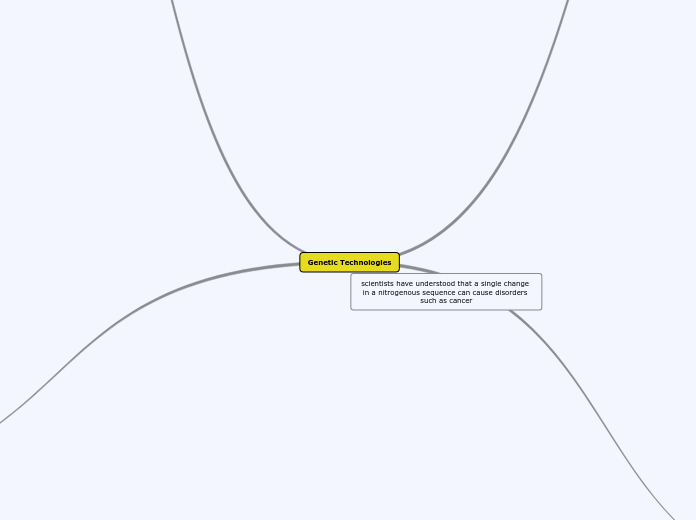scientists have understood that a single change in a nitrogenous sequence can cause disorders such as cancer
Genetic Technologies
Gene Therapy
it is hard to find vectors that reach all or most of the target cells
constant gene therapies are required as cells are constantly dividing because of mitosis, the normal genome must become a permanent part of the cell genome
using a virus as a vector can be risky, as the human body may want to fight back the virus; making it ineffective
there is no way to control where the genome will be inserted into the cells DNA; this has a possibility to disrupt normal cell processes
although gene therapy is used on animals to help them fix their genetic disorders, scientists are still unknown to the long term affects once they are released back into the environment.
animals that mate with other animals that have gone through gene therapy have unknown results
leads to an increase in abortions, as couples that discover that they or their baby carries diseases will not proceed with birth
raises controversy, brings up ethical/legal problems as many people think it is a invasion of privacy
it is very expensive as insurances do not fully cover for this type of therapy
Subtopic
in animals, it is able to restore deafness
a study in 2005 on pigs was done to restore the hairs in their ears that help them hear
allows people who have genetic disorders, diseases, as well as cancer to live out a normal life
shown promise in restoring inherited blindness
Process of Gene Therapy
3. Large numbers of the viruses infect the target cells in an attempt to insert the normal human DNA into the cell’s genome.
2. The normal gene along with the copies of the DNA is placed inside each virus and are incorporated into the virus’s own DNA.
1. Scientists remove or alter the DNA, so it cannot harm the cells that they enter.
an experimental technique used by scientists to overcome the negative effects of a defective gene by adding a normal gene to repair the defective one.
to insert a normal gene into the genome, a specialized DNA sequence, called a vector is used to carry the gene into the target cells
Vector: any agent, such as a plasmid or a virus that is capable of inserting a piece of foreign DNA into a cell
the cells in which the gene needs to be replaced or repaired are known as target cells
Genetically Modified Organisms
scientists are unaware what will happen to the environment once modified organisms are entered into the wild life
genetically modified crops that animals eat may change their normal functions as animals
in the past that, rats have developed kidney and liver problems from consuming GMOs
GMO testing is mainly used on animals first which many people see as unethical
people believe GMO's are bad for them and can cause allergic reactions
GMO's can be used for agricultural purposes, as food can be genetically modified to be less susceptible to rotting, to enhance nutritional value, and to make crops resistant to pests and herbicides
e.g. Bt Corn
GMO manipulation in animals can be used to make their cells healthier and save them from becoming endangered
bacteria can be manipulated to create insulin for people with diabetes
certain helpful resources can be made and produced from animals and insects that are genetically modified. This can be turned into applications for new materials and manufacturing
e.g. Spider Silk
The process of introducing, selecting, and recombining genes from one organism to
another organism to change the build of the organism itself.
the genetic modification process
Products of Genetic Engineering
Example 2: Bt Corn
is able to produce its own pesticides against various insects, hence it reduces the need to spray the crop with synthetic pesticides
Example 1: Spider Silk
five times as strong as steel, waterproof, ductile, stretches 30% more than most elastic nylons
the use of plasmids and restriction enzymes led to modern recombinant DNA techniques
Steps
5. The bacteria enters a environment with the plants and it is able to enter the plant cells and incorporate the new gene into the plants genome. Now the cod anti freeze gene is in the plant gene so that plants can now resist cold weathers.
4. The plasmid (bacteria with cod gene) is entered into a bacterium.
3. The cut DNA from the organism is inserted into the plasmid and joined by another enzyme.
2. A plasmid is used and cut with the same restriction enzyme as the organism
1. An organism of desired characteristic (gene) is chosen
Recombinant DNA: a fragment of DNA consisting of nucleotide sequences from at least two different sources
this DNA is made with two pieces of DNA that have been cut with the same restriction enzyme, once they are cut with both the sticky ends of each DNA can connect with each other.
Plasmids and Restriction Enzymes are used to cut out a gene from one organism and insert it into another
Plasmid: a small circular piece of DNA that can enter and exit bacterial cells
Restriction Enzyme: a molecule that has the ability to cut DNA at a specific site
genes can come from bacteria, viruses, insects, animals or even humans
DNA Identification
DNA evidence can be planted at crime scenes which may lead to false accusations towards people
it requires uncontaminated or untainted DNA otherwise it cannot be used.
This technology is complicated and also time-consuming to use effectively
as DNA identification can be costly, people believe that the money used for DNA collection of endangered species can be used to save the species instead
violates peoples privacy as it makes their personal genetic information available to others
people feel that they should be able to choose whether or not they want to share their DNA
reveals a lot of information about a persons DNA
can be analyzed to prepare for future disease that they may be susceptible to.
possibility of saving endangered species in the future as their DNA can be stored in the banks.
helps people learn more about their heredity and family members
People who are separated from their families can reconnect with them through this.
helps solve crimes as criminals who leave body tissue at crimes scenes can easily be identified through this method
this can be found from skin cells, fingernails, or fluids from rape victims. Furthermore, decomposed bodied that are unidentifiable can be identified
A method of identifying a particular individual through samples (hair, blood, etc.) of their DNA
DNA Fingerprinting: a pattern of bands on a gel that is unique to each individual
example of DNA Fingerprinting
Uses of the Technology
used by police and detectives to find guilt, settle paternity lawsuits, determine ancestry, and identify remains of a person that is not recognizable by the face
National DNA Data Bank
a bank of DNA from thousands of criminals that is used to link crimes, identify suspects, and many more. Many cases have been solved due to this and innocent people have been saved
they separate the DNA fragments of the individual from the gel.
is a common way to identify an individual using their DNA
DNA Fingerprinting is characteristic of each individual but highly variable from person to person
DNA Bank: a database of DNA sequences; the sequences can be from plants, animals, or humans
This bank also stores DNA from endangered and extinct species in which scientists hope to bring back in the future
in these banks, the DNA is not sequences on a computer or studied, it is frozen for future use
DNA is extracted from an individual's blood and then stored in a freezer
people can have their DNA screened for numerous genetic disorders and also be able to store their DNA in a DNA Bank
Human Genome Project
Negative
it is very costly to use
companies that use this technology will have concerns over patents and rights to the technology
research and testing on species can harm or kill them, which can eventually damage their populations
may cause a loss is genetic diversity
people with privacy and confidentiality concerns believe that their privacy rights are violated.
people who have risk of getting diseases may not be able to obtain insurance as life insurance companies favor healthy people
people may live with a constant fear of developing a diseases if they know their genetic makeup and risks of developing one
Aspects and Impacts
Positive
Additional
can hels understand the evolution and migration of humans by analyzing and understanding the genome.
Environmental
has the ability to help farmers with livestock breeding.
can helps create disease resistant crops and animals
Social
this would help create new medicine, as it can be changed to become more effective based on the individuals genome.
with this technology genetic tests can predict diseases that people may be prone to or have risk of
this helps with diagnosing and preventing diseases.
Description
A collaborative worldwide project to sequence the nitrogenous bases in human DNA
HGP is a method to understand human genome at a molecular level, and after identifying it, new applications have begun
mapping of the DNA is leading to medical advances
research is being done on identifying individual genes and understanding the function they do is being done.
this is known as Functional Genomics
in 2000, Celera Genomics and the HGP announced that they had deciphered the human genome sequence
a more computerized approach was used
This computer screen displays a human DNA sequence as a series of colored bands
in 2003 a more complete version was announced which had 2.83 billion nuceleotides sequenced
over 2000 scientists contributed to the project
tests were done on model organisms such as mice or apes that have similar qualities of DNA such as the genes, locations, and nitrogenous pairs
Mice and Humans have similar DNA
collected blood from females and sperm from males
scientists exchanged information about their research among each other through emails, articles in scientific journals, conferences, laboratories
launched in 1990, with the goal of determining the 3 billion nitrogenous base sequences of human DNA
The Human Genome is the sequence of DNA nitrogenous bases found on the 23 sets of chromosomes in humans. There are two regions in the genome
Non-Coding DNA
a region of DNA that does not contain a sequence of nucleotides that will be expressed, makes up the other 98 percent. Also known as junk which does not do much.
Coding DNA
a region of DNA that contains a sequence of nucleotides that will be expressed, makes up 2% of the human genome.









